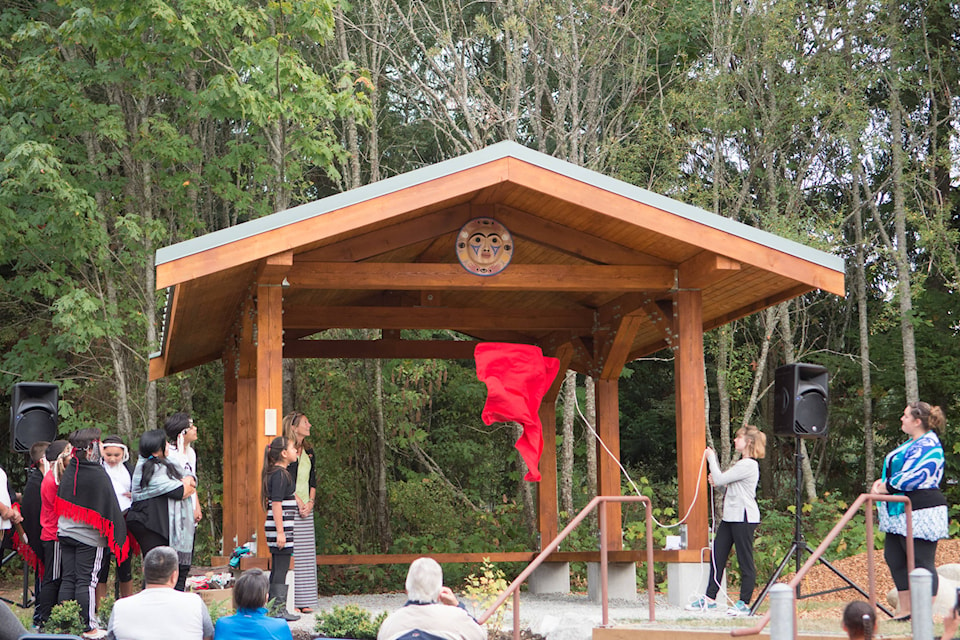On Thursday, Bayside Middle School had its annual Meet the Teacher night, a key part of every new school year. Volunteers served burgers and parents mingled as usual, but there was one addition to the program: the unveiling of a new outdoor learning space and peace garden around back.
Parents and children filtered in from the barbecue and watched the ceremony. Megan Supernault, an Indigenous education assistant at Bayside, said it is a remarkable change from when she was in school in the ’90s.
“I think about myself when I was in middle school and being Aboriginal I felt kind of lost and unheard,” said Supernault. “It made it harder, so to get to see the public school system open its arms and bring that to our Indigenous and non-Indigenous students and families, for them to witness what happened last night was huge. And I think for our students it was empowering, too.”
Wendy Macdonald, principal at Bayside Middle School, said this change in attitude is due to years spent building trust and relationships with local First Nations and the W̱SÁNEĆ tribal school. Bayside has Indigenous students, so she said it made sense to offer culturally relevant teachings from Indigenous teachers like Supernault and Ivy Seward, who began teaching SENĆOŦEN at Bayside in 1999.
SENĆOŦEN in its written form was created by Dave Elliott Sr. in the winter of 1978. A Tsartlip man and former commercial fisherman, he saw the urgent need to revitalize the language and culture after the federal government tried for years to eliminate it by forcing Indigenous children into residential schools where the language and culture was banned. Important stories had to be recorded, fast, while aging knowledge holders were still alive. The writing system also had to be accessible.
In a collaboration with the University of Victoria’s linguistics department, the sounds of the language were written down by overstriking the 26 English letters on a standard typewriter with hyphens, slashes, underscores, and accents so no expensive, specialized equipment was required. The program has now spread to Bayside, where both Indigenous and non-Indigenous students can enter a SENĆOŦEN-enriched program. The goal is to eventually make it an official immersion program with more instruction hours. Macdonald said that growing interest, from Indigenous and non-Indigenous learners alike, will soon make an immersion program viable, pending negotiations with the Ministry of Education.
“Because this school has a dual-track, there’s no reason why it can’t be tri-track,” said Macdonald.
With the understanding that language and culture cannot be separated, Bayside eventually began incorporating the Saanich Moons curriculum, a generations-old system which is land-based and tied to the seasons.
“The kids in the fall would make the spears, go to Goldstream, come back, and it required us to build a smokehouse to smoke the fish,” said Macdonald. “We brought community in as part of the sharing. Your first catch is shared. Then we realized these children were feeling so proud, and their identity was shifting in a public school so then if this was happening, we wanted to go bigger.”
The outdoor classroom, called NEPENEḴÁUTW̱ (Place of Teaching) was proposed last year by a parent, Tamara Lorincz, who spearheaded a similar project in Ontario. Since construction workers were already at Bayside to replace a leaking roof, the timing was perfect.
Supernault said the outdoor classroom will allow children who speak SENĆOŦEN to hear it in the environment it was meant to be heard in, rather than in the classroom. However, any Bayside class is welcome to use the space. Former PAC president Marti Redman said that “every teacher is already clamoring to just use nature in their learning.”
Sadie Richards, a non-Indigenous Grade 8 student, helped unveil the classroom because her great-grandfather, David Kennedy, operated the pile driver at Beacon Hill Park when the 39-metre totem pole was raised in 1956. Because of this family history, she got to unveil another totem pole at Bayside last year, carved by Mark Henry, that reflects virtues embodied by Bayside students.
“At the totem pole unveiling last year, it was really cool how they got, I think it was cedar water, and they brushed it over the tree, blessing it. And then we each got a candle, and I still have my candle in my room as a part of the ceremony,” she said.
Macdonald also said Indigenous parents who were skeptical of a Western school’s ability to nurture their children have started to come around. Attendance among Indigenous children, she said, is much stronger than it was 15 years ago.
“For me, and I don’t think it’s a secret, the Indigenous kids, particularly the kids that live on reserve, come to the school with that lost, ‘where do I fit in’ feeling, and my vision is to find ways for these kids to be leaders, to be proud, to have dignity when they leave our school in Grade 8, to have the privileges that everyone else has in this world,” said Macdonald.
Jaden Sampson, a Grade 7 student, spoke at the unveiling and said that he picked up SENĆOŦEN easily after learning French for a few years.
“My mom knows SENĆOŦEN and we’ve all been teaching my baby brother SENĆOŦEN. He understands what it means.”
reporter@peninsulanewsreview.com
Like us on Facebook and follow us on Twitter



